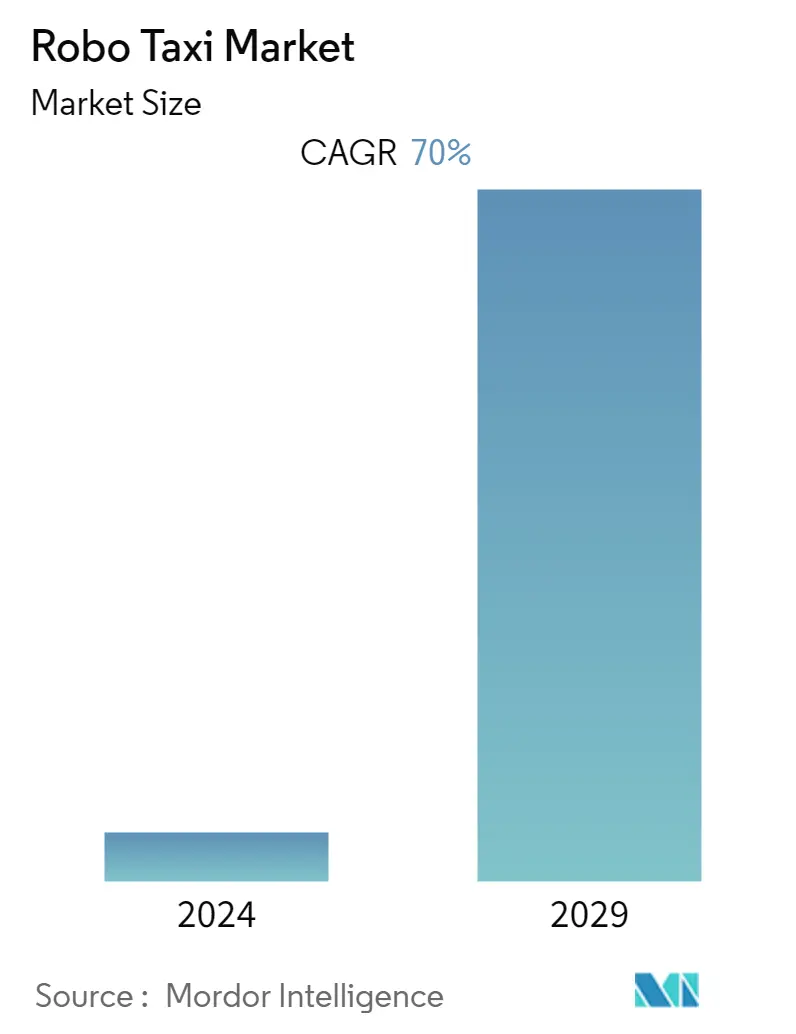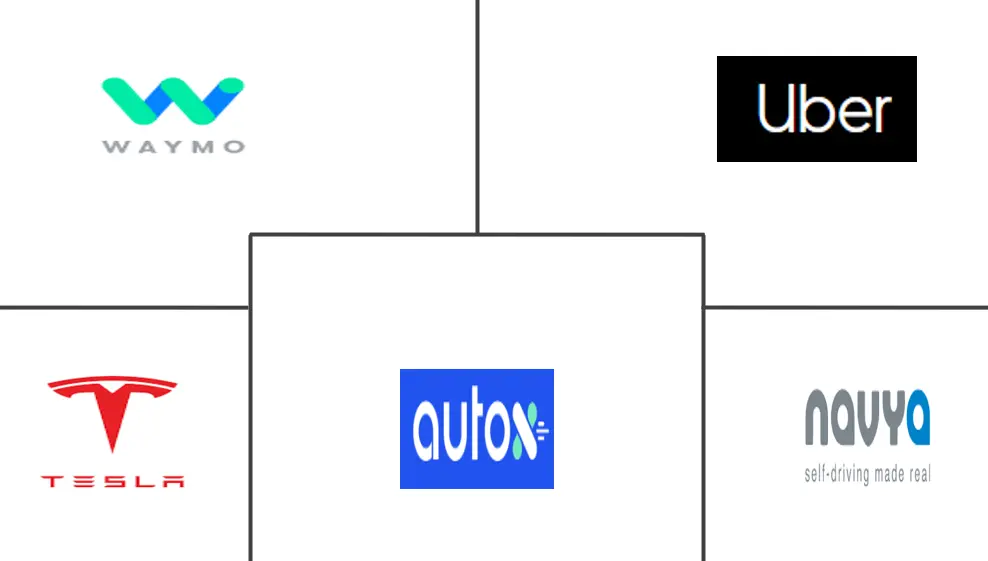Market Size of Robo Taxi Industry

| Study Period | 2019 - 2029 |
| Base Year For Estimation | 2023 |
| CAGR | 70.00 % |
| Fastest Growing Market | Asia-Pacific |
| Largest Market | Europe |
| Market Concentration | Medium |
Major Players
*Disclaimer: Major Players sorted in no particular order |
Robo Taxi Market Analysis
The Robo-taxi market was valued at USD 1.2 Billion in 2021 and is projected to grow to USD 28.11 Billion by 2027, registering a CAGR of 70% during the forecast period.
The COVID-19 pandemic had a massive impact on the market studied as lockdowns and trade restrictions have led to supply chain disruptions and a halt of vehicle production across the world. Due to the strict lockdown, several companies extended to launch Robo-taxi ride-hailing services. For instance, In 2020, Waymo postponed its ride-hailing services due to a lockdown. However, as restrictions eased, players started focusing on mitigating such risks and developments to create momentum in the market during the forecast period.
Over the medium term, the rise in the integration of advanced driver assistance in an autonomous vehicle is likely to witness major growth during the forecast period. Additionally, technological advancements in advanced driver assistance systems and a growing emphasis on multifunctional systems create lucrative opportunities for players to develop autonomous vehicles.
The growing issues of traffic congestion in major cities around the world, increase pollution and adversely impact health and overall quality of life. The demand for zero-emission vehicles or green vehicles is rising, also there is a surge in autonomous cars demand. Currently, three trends are accelerating transformative change in the automotive industry which are zero-emission vehicles, autonomous driving, and new mobility models. Autonomous, zero-emission Robo-taxis embody all three of these trends, offering the potential for convenient, personalized transport as an attractive alternative to owning a car or using public transport.
Robo-taxis are still in testing phases and carries the baggage of challenges which includes, high manufacturing cost, the risk of injury to drivers and pedestrians, lack of proper government regulations, and inadequate infrastructure for operating Robo-Taxis. These factors are likely to hinder the growth of the robot-taxi market.
However, Robo-taxis also provide an opportunity to significantly increase traffic capacity by reducing safe stopping distances between cars. As robots can react almost instantly, it is reasonable to reduce the enforced safe distance while still expecting higher safety levels.
Robo Taxi Industry Segmentation
Robo-taxi is a driverless taxi that is operated as an on-demand mobility service. Robo-taxi is a fully autonomous vehicle that can pick up and drop off passengers without the need for a driver.
The Robo-taxi market is segmented into the level of autonomy, drive type, application, vehicle type, service type, and geography. Based on the level of autonomy, the market is segmented into Level 4 and Level 5. Based on the drive type, the market is segmented into Electric vehicles, Hybrid Vehicles, and Fuel Cell Electric Vehicles. Based on the vehicle type, the market is segmented into Car and Van/Shuttle. Based on the application, the market is segmented into passenger transportation and goods transportation. Based on the service type, the market is segmented into rental-based and station-based. Based on geography, the market is segmented into North America, Europe, Asia-Pacific, and the Rest of the World. For each segment, the market sizing and forecast have been done on the basis of value (USD Billion).
| By Level of Autonomy | |
| Level 4 | |
| Level 5 |
| By Propulsion | |
| Electric Vehicles | |
| Hybrid Vehicles | |
| Fuel Cell Electric Vehicles |
| By Vehicle | |
| Car | |
| Van/Shuttle |
| By Application | |
| Passenger Transportation | |
| Goods Transportation |
| By Service Type | |
| Rental-Based | |
| Station-Based |
| Geography | ||||||||
| ||||||||
| ||||||||
| ||||||||
|
Robo Taxi Market Size Summary
The Robo-taxi market is poised for significant expansion, driven by advancements in autonomous vehicle technology and the increasing demand for zero-emission transportation solutions. The market is experiencing transformative changes due to the convergence of three key trends: the rise of autonomous driving, the push for zero-emission vehicles, and the development of new mobility models. Robo-taxis, which integrate these trends, offer a promising alternative to traditional car ownership and public transport, potentially enhancing convenience and personalization in urban mobility. Despite the challenges posed by high manufacturing costs, regulatory hurdles, and infrastructure limitations, the market is witnessing a surge in interest and investment from major automotive and technology companies globally. The COVID-19 pandemic initially disrupted market growth, but as restrictions eased, companies refocused on innovation and risk mitigation to capitalize on emerging opportunities.
Regionally, Europe is leading the Robo-taxi market, supported by advanced mobility technologies and favorable regulatory frameworks. The continent's infrastructure and regulatory support have created a conducive environment for the deployment of autonomous vehicles. China and the United States are also key players, with significant developments in autonomous vehicle testing and deployment. Companies like Waymo, Uber, and Baidu are actively testing and launching Robo-taxi services, while partnerships and strategic collaborations are being formed to enhance technological capabilities and market reach. The market remains in its early stages, with a limited number of players, but the ongoing advancements and strategic initiatives are expected to drive substantial growth in the coming years.
Robo Taxi Market Size - Table of Contents
-
1. MARKET DYNAMICS
-
1.1 Market Drivers
-
1.2 Market Restraints
-
1.3 Industry Attractiveness - Porter's Five Force Analysis
-
1.3.1 Threat of New Entrants
-
1.3.2 Bargaining Power of Buyers/Consumers
-
1.3.3 Bargaining Power of Suppliers
-
1.3.4 Threat of Substitute Products
-
1.3.5 Intensity of Competitive Rivalry
-
-
-
2. MARKET SEGMENTATION (Market Size by Value - USD Billion)
-
2.1 By Level of Autonomy
-
2.1.1 Level 4
-
2.1.2 Level 5
-
-
2.2 By Propulsion
-
2.2.1 Electric Vehicles
-
2.2.2 Hybrid Vehicles
-
2.2.3 Fuel Cell Electric Vehicles
-
-
2.3 By Vehicle
-
2.3.1 Car
-
2.3.2 Van/Shuttle
-
-
2.4 By Application
-
2.4.1 Passenger Transportation
-
2.4.2 Goods Transportation
-
-
2.5 By Service Type
-
2.5.1 Rental-Based
-
2.5.2 Station-Based
-
-
2.6 Geography
-
2.6.1 North America
-
2.6.1.1 United States
-
2.6.1.2 Canada
-
2.6.1.3 Rest of North America
-
-
2.6.2 Europe
-
2.6.2.1 Germany
-
2.6.2.2 United Kingdom
-
2.6.2.3 France
-
2.6.2.4 Italy
-
2.6.2.5 Spain
-
2.6.2.6 Rest of Europe
-
-
2.6.3 Asia Pacific
-
2.6.3.1 China
-
2.6.3.2 Japan
-
2.6.3.3 India
-
2.6.3.4 Rest of Asia-Pacific
-
-
2.6.4 Rest of the World
-
2.6.4.1 South America
-
2.6.4.2 Middle East and Africa
-
-
-
Robo Taxi Market Size FAQs
What is the current Robo Taxi Market size?
The Robo Taxi Market is projected to register a CAGR of 70% during the forecast period (2024-2029)
Who are the key players in Robo Taxi Market?
Waymo LLC, Uber Technologies Inc., Navya, SA, AutoX Inc. and Tesla Inc. are the major companies operating in the Robo Taxi Market.

